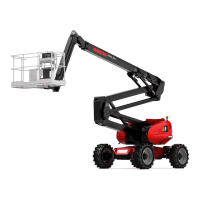1 - 9
IMPORTANT
Do not use this machine during lightning storms, snow storms, during frosty periods or in hazardous weather conditions. In case of strong wind exceeding 45 km/h, do not
make any movement that may endanger the platform’s stability.
- To visually recognise this wind speed, refer to the empirical wind evaluation scale below:
BEAUFORT scale (wind speed at a height of 10 m on a flat site)
Force Type of wind
Speed
(knots)
Speed
(km/h)
Speed (m/s) Effects on Land Sea conditions
0 Calm 0 - 1 0 - 1 <0.3 Smoke rises vertically. Sea is like a mirror.
1 Light air 1 - 3 1 - 5 0.3 - 1.5 Smoke indicates direction of wind. Ripples with appearance of scale, no foam crests.
2 Light breeze 4 - 6 6 - 11 1.6 - 3.3 Wind felt on face, leaves rustle. Short wavelets, but pronounced.
3 Gentle breeze 7 - 10 12 - 19 3.4 - 5.4 Leaves and small twigs in constant motion. Very small waves, crests begin to break.
4 Moderate breeze 11 - 16 20 - 28 5.5 - 7.9
Wind raises dust and loose pieces of paper; small
branches are moved.
Small waves, becoming longer, numerous
whitecaps.
5 Fresh breeze 17 - 21 29 - 38 8 - 10.7 Small tees in leaf begin to sway.
Wavelets form on inland waters; moderate waves,
taking longer form.
6 Strong breeze 22 - 27 39 - 49 10.8 - 13.8
Large branches in motion, whistling heard in
overhead wires, umbrella use becomes difficult.
Larger waves forming, whitecaps everywhere,
some spray.
7 Near gale 28 - 33 50 - 61 13.9 - 17.1
Whole trees in motion, inconvenience felt when
walking against the wind.
Sea heaps up; white foam from breaking waves begins
to be blown in streaks along the direction of the wind.
8 Gale 34 - 40 62 - 74 17.2 - 20.7 Wind breaks twigs off trees; impedes progress.
Moderately high waves of greater length; edges
of crests begin to break into spindrift.
9 Strong gale 41 - 47 75 - 88 20.8 - 24.4 Wind damages roofs (chimneys, slates, etc.).
High waves, crests of waves begin to topple,
streaks of foam; reduced visibility.
10 Storm 48 - 55 89 - 102 24.5 - 28.4
Seldom experienced inland; trees uprooted;
considerable structural damage occurs.
Very high waves; white streaks of foam; reduced
visibility.
11 Violent storm 56 - 63 103 - 117 28.5 - 32.6 Very rare, widespread damage.
Exceptionally high waves able to hide medium
sized ships from view, reduced visibility.
12 Hurricane 64 + 118 + 32.7 + Devastating damage.
Sea completely white; air filled with foam and
spray, very reduced visibility.
D - VISIBILITY
- Ensure good visibility on your route at all times. To increase your visibility, you can move forwards with the jib arm slightly
raised (beware of the risk of falls in the basket from knocking into a low doorway, overhead electric wires, travelling
cranes, highway bridges, rail tracks or any obstacle in the area in front of the platform). In reverse, look directly behind
you. At all events, avoid reversing long distances.
- If visibility of your road is inadequate, ask someone to help, standing outside the area in which the platform will bemoving,
and make sure you always have a good view of this person.
E - STARTING-UP THE ENGINE-POWERED PLATFORM
SAFETY INSTRUCTIONS
- If using an emergency battery for start-up, use a battery with the same characteristics and respect battery polarity when
connecting it. Connect the positive terminal first, and then the negative terminal.
IMPORTANT
Failure to respect polarity between batteries can cause serious damage to the electrical circuit.
The electrolyte in the battery may produce an explosive gas.
Avoid flames and generation of sparks close to the batteries. Never disconnect a battery while it is being charged.
INSTRUCTIONS: 2-DESCRIPTION.
E - STARTING UP THE ELECTRIC-POWERED PLATFORM
SAFETY INSTRUCTIONS
- Do not use the platform if the battery is discharged to the point that movements are slowed down. In certain cases,
theplatform may stop (
2-DESCRIPTION for the charge level not to be exceeded).
INSTRUCTIONS:
2-DESCRIPTION.

